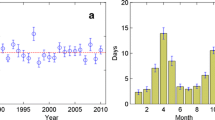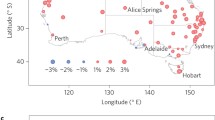Abstract
Thunder-day occurrences during a 100-year period based on data from carefully screened records of 86 first-order stations distributed across the United States were assessed for temporal fluctuations and trends during 1896–1995. Short-term (<10-year) fluctuations of adjacentstations were often dissimilar reflecting localized differences in storm activity in a few years, making spatial interpretations difficult. But, temporal fluctuations based on 20-year and longer periods exhibited regional coherence reflecting the control of large, synoptic-scale weather systems on the distribution of thunderstorms over broad areas. Classification of station fluctuations based on 20-year periods revealed six types of distributions existed and they formed 12 discrete areas across the nation. One type present in the lower Midwest and the South had a peak in storm activity in 1916–1935 followed by a general decline to 1976–1995.A second type maximizing at the same time had its minimum earlier, in 1956–1975. Another distribution found at stations in the upper Midwest and Northeast had a mid-century peak (1936–1955) with a recent minimum in1976–1995. A fourth distribution also peaked in 1936–1955 but had an early minimumin 1896–1915, and it mainly occurred in the northern plains and Rocky Mountains. A fifth distribution peaked during 1956–1975 and was foundat stations in four areas including the central High Plains, Southwest, northern Great Lakes, and Southeast. The sixth temporal distribution showed a steady increase in storm activity during the 100-year period, peaking in 1976–1995, and covered a large area extending from the Pacific Northwestacross the central Rockies and into the southern High Plains. The national average distribution based on all station values peaked in mid century. The national distribution differs markedly from several regional distributions illustrating the importance of using regional analysis to assess temporal fluctuations in severe weather conditions in the nation. The 100-year linear trends of the 86 stations defined six regions across the U.S. Significant upward trends existed over most of the western two-thirds of the nation, unchanging trends existed in the northern plains and Midwest, and downward trends were found in most of the nation's east. The up trends in storm-day frequencies in the southern plains occurred where storm damage is greatest and where demographic changes have added to storm losses over time. The national patterns of trends and storm distributions were similar to those found for hail. The temporal distributions of storm activity helped explain recent increases in major storms and their losses, conditions which have increased in the west and south.
Similar content being viewed by others
REFERENCES
Byers, H. R. and Braham, R. R.: 1949, The Thunderstorm, U.S. Weather Bureau, Washington, D.C., p. 287.
Changnon, S. A.: 1966, 'Effect of Lake Michigan on Severe Weather', J. Great Lakes Res. 15, 220–234.
Changnon, S. A.: 1999, 'Factors Affecting Temporal Fluctuations in Damaging Storm Activity in the U.S. Based on Insurance Loss Data', Meteorol. Appl. 6, 1–11.
Changnon, S. A.: 2001a, 'Assessment of Quality of Thunderstorm Data at First-Order Stations', J. Appl. Meteorol., in press.
Changnon, S. A.: 2001b, 'Damaging Thunderstorm Activity in the U.S.', Bull. Amer. Meteorol. Soc., in press.
Changnon, S. A.: 2001c, A Thunderstorm Database and Analysis of Storms for the United States, Changnon Climatologist, Mahomet, IL, p. 67.
Changnon, S. A. and Changnon, D.: 1999, 'Long-Term Fluctuations in Hail Incidences in the United States', J. Climate 13, 658–664.
Changnon, S. A. and Huff, F. A.: 1980, Review of Illinois Summer Precipitation Conditions, Bulletin 64, Illinois State Water Survey, Champaign, IL, p. 56.
Changnon, S.A., Pielke, Jr., R. A., Changnon, D., Sylves, R., and Pulwarty, R.: 2000, 'Human Factors Explain the Increased Losses from Weather and Climate Extremes', Bull. Amer. Meteorol. Soc. 81, 437–442.
Donaldson, R. J., Chemla, A. C., and Shackford, R.: 1960, 'Some Behavior Patterns of New England Storms', Physics of Precipitation, Geophysics Monograph 5, Amer. Geophysical Union, pp. 354–368.
Gabriel, K. R. and Changnon, S. A.: 1990, 'Temporal Features in Thunder Days in the United States', Clim. Change 15, 455–477.
Huff, F. A. and Changnon, S. A.: 1973, 'Precipitation Modification by Major Urban Areas', Bull. Amer. Meteorol. Soc. 54, 1220–1232.
Karl, T. R., Knight, R. W., Easterling, D. R., and Quayle, R.: 1996, 'Indices of Climate Change for the U.S. Climate', Bull. Amer. Meteorol. Soc. 77, 279–292.
Kessler, E. and White, G. F.: 1981, 'Thunderstorms in a Social Context', in Kessler, E. (ed.), The Thunderstorm in Human Affairs, Volume 1, A Social, Scientific and Technological Documentary, National Oceanic and Atmospheric Administration, Washington, D.C., pp. 1–22.
Kunkel, K. E., Pielke, Jr., R. A., and Changnon, S. A.: 1999, 'Temporal Fluctuations in Weather and Climate Extremes that Cause Economic and Human Health Impacts: A Review', Bull. Amer. Meteorol. Soc. 80, 1077–1098.
Liaw, Y. P, Sisterson, D. L., and Miller, N.: 1990, 'Comparison of Field, Laboratory, and Theoretical Estimates of Global Nitrogen Fixation by Lightning', J. Geophys. Res. 95, 22489–22494.
Ludlam, F. H.: 1981, 'The Meteorological Role of Cumulus and Cumulonimbus', in Kessler, E. (ed.), Thunderstorms: A Social, Scientific and Technological Documentation, Volume 2, University of Oklahoma Press, Norman, pp. 1–8.
Osborn, H. and Hickcock, R.: 1968, 'A Variability of Rainfall Affecting Runoff from Semi-Arid Watersheds', Water Resour. Res. 4, 1990–2003.
Semonin, R. G.: 1976, Study of Air Pollution Scavenging, Contract Report 172, Illinois State Water Survey, Champaign, IL, p. 13.
Wallace, J. M.: 1975, 'Diurnal Variations in Precipitation and Thunderstorm Frequency over the Conterminous United States', Mon. Wea. Rev. 103, 406–419.
Weather Bureau: 1947, Thunderstorm Rainfall, Hydrometeorological Report No. 5, U.S. Department of Commerce, Vicksburg, MS, p. 331.
Author information
Authors and Affiliations
Rights and permissions
About this article
Cite this article
Changnon, S.A., Changnon, D. Long-Term Fluctuations in Thunderstorm Activity in the United States. Climatic Change 50, 489–503 (2001). https://doi.org/10.1023/A:1010651512934
Issue Date:
DOI: https://doi.org/10.1023/A:1010651512934




